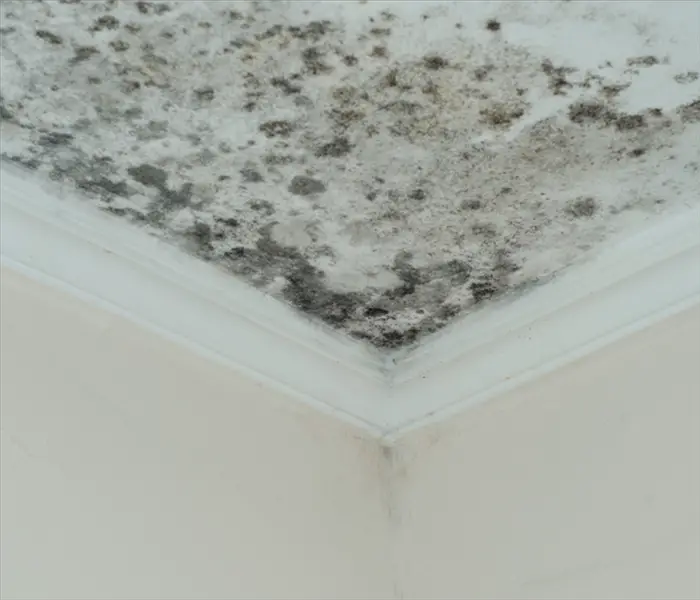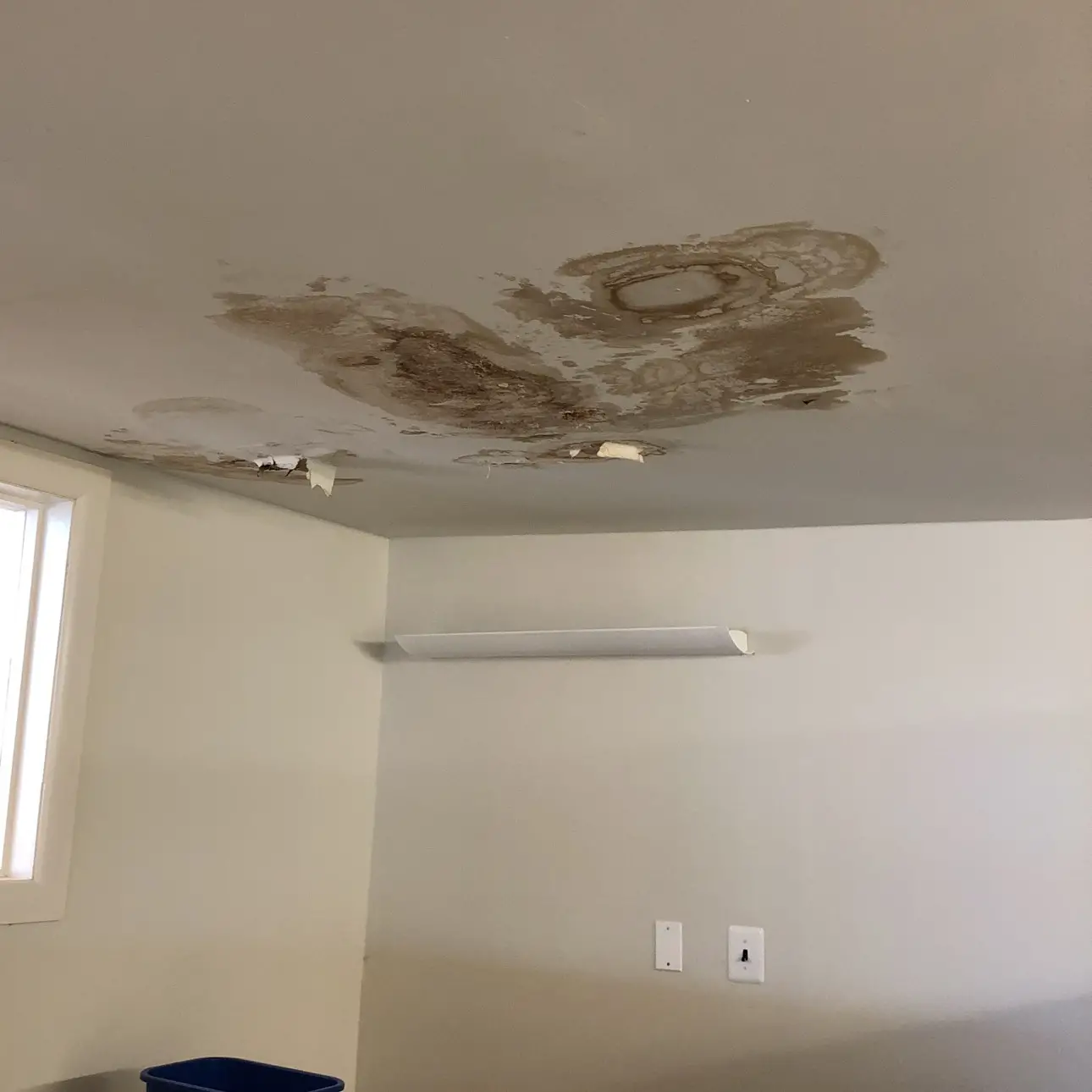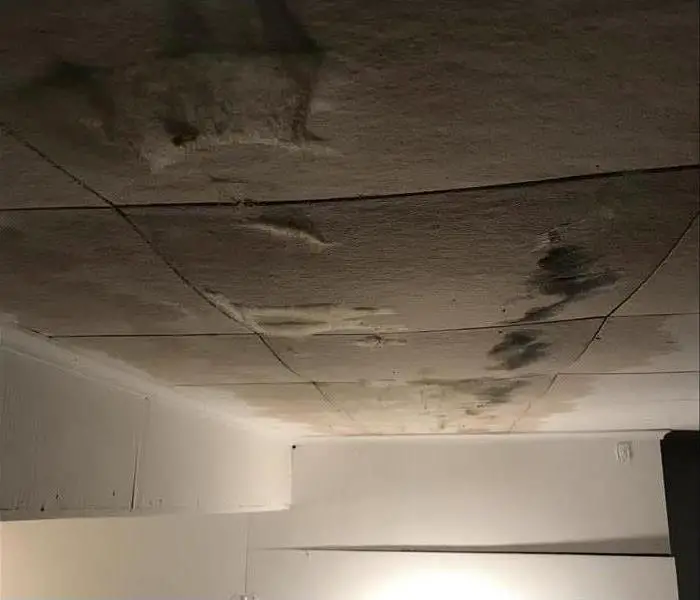Safety For Ceiling Cleaning
When using a ladder to clean a ceiling you need to follow a few extra steps, so to speak. Make sure the metal braces of the ladder are locked down and straight before climbing the ladder. Keep your hips within the vertical rails when you are stretching to the right or left to clean the mold off of the ceiling. This will keep you from toppling over. Keep one hand securely on the ladder when bending back so that you, and the ladder, dont go tumbling backward.
Never stand on the paint shelf or the top step of the ladder. When using a bucket of cleaning solution, secure the bucket to the ladder so you arent steadying it while also reaching out to clean the ceiling.
Strong commercial cleaners or homemade cleaners that are ammonia- or bleach-based can irritate your eyes and lungs. Wear a dust mask or chemical mask along with a good pair of work gloves and protective eyewear that wraps around your eyes.
When To Call A Professional
While being able to handle a mold problem on your own is most certainly easier at first, sometimes a professional needs to be called to help make sure the entire problem is solved.
- If the mold is growing rapidly and in multiple areas on your ceiling, call a professional. This could be for many reasons, but a leak is highly likely and will need to be handled quickly.
- If you are having health issues due to the mold, it is best to call a professional so you are not putting yourself more at risk than you already are. Professionals have the proper knowledge and equipment to safely remove the mold for you.
- If you have tried to clean the mold on ceiling yourself and it keeps coming back, you should call a professional. If this is the case, there is something more going on that needs to be looked at. Let a professional with the proper tools help make your bedroom safe.
We have Mold Remediation Specialists that can help Find the Source of the Mold on your Ceiling, Remove it & Prevent it from Returning.
For Disasters of all Sizes,available in 95% of the USA
The Dangers Of Mold On Bathroom Ceilings And How To Protect Yourself
Mold can cause several health problems, including respiratory problems, headaches, and skin irritation. It can also trigger allergies and asthma attacks. If you have mold in your bathroom, it’s important to take steps to remove it and prevent it from coming back. If you’re allergic to mold, the best way to protect yourself is to avoid exposure to it. If you must enter a room with lots of mold, be sure to wear a mask and gloves. You should also try to keep the area well-ventilated by opening windows or using an air purifier.
Don’t Miss: How Do You Get Rid Of Mold On Furniture
How Do I Stop Mold From Growing On My Bathroom Ceiling
If you dont eliminate the source of the issue, it will come back. In this case, if moisture persists in your bathroom, you can expect this fungus to return. Fortunately, you can do a few things to prevent it from growing on your bathroom ceiling:
- Improve air circulation by opening a window or adding a circulating fan
- Clean the shower and tub regularly
- Dry your shower with a squeegee or towel after every use
- Wash shower curtains, towels, liners, and bath rugs regularly
- Invest in a dehumidifier and turn it on after you shower.
Identify The Cause Of Ceiling Mold Growth

Common in older homes, excessive humidity and poorly insulated ceilings can lead to mold growth on ceilings. Mold growth due to humidity is often identifiable by the growth pattern. A trained professional can usually diagnose the cause of ceiling mold with just a quick glance. The following are clues for each of the moisture source.
Symptoms of humidity based mold growth:
- Mold growth is worse at the perimeter of the room
- The room is on the top floor
- The attic is poorly insulated
Symptoms of mold due to roof leaks:
- Discoloration is brown/yellow
- Mold/staining follows as circular pattern
- Mold growth is confined to a single region
Read Also: Who Inspects Mold In Houses
Mold On Bathroom Ceiling: Wipe Out With Diy Remedies
Stefan GheorgheTypes Of Mold On Bathroom CeilingIs Bathroom Ceiling Mold Harmful
When you notice mold on the bathroom ceiling, it can be a little scary. Your bathroom is the perfect breeding ground for mold. If you do not remove bathroom mold, you and your family could contract serious illnesses.
Mold grows rapidly, and more so in a shower stall, which is an unappealing sight. In most cases, mold issues are the result of poor ventilation. Fortunately, there are DIY methods that can help you clean mold.
What Causes Ceiling Mould
In the home, indoor mould grows due to excess moisture, poor ventilation and lack of natural light. Ceilings make for excellent spaces for mould growth for many reasons. For example, roofs can crack and leak outside water into ceilings leading to mould growth. Also, roof cavities are often dark and can be poorly ventilated allowing mould growth to spread to ceilings. Finally, condensation from use of appliances, cooking, drying clothes, windows, showering and indoor plumbing can cause water to collect on ceiling surfaces, resulting in mould growth.
Indoor ceilings, like most building materials, are often made from organic materials. This means mould growth can damage and degrade ceilings. So, if left untreated, mould can cause permanent stains on ceilings or even cause significant structural damage to a property.
Also Check: How To Get Mold Smell Out Of Camper
Remediation Of Ceiling Mold Growth
Assess the ceiling’s insulation content first. Your home’s attic ceiling is probably insulated.
Warning: if the attic insulation is on the roof sheathing, the top-level ceilings may be uninsulated. But this is a novel setup. Inner ceilings are seldom insulated. Rarely a later-installed second story will be an exception to this. Some houses also include sound-proofing insulation in the ceilings.
It is simpler to treat mold development on uninsulated inner-building ceilings. Mold development needs both a food supply and accessible moisture. Mold loves Sheetrock, particularly the paper backing. Moisture is the only component that can be influenced. Uninsulated ceilings are advantageous here. The absence of insulation allows air to travel freely on both sides of the sheetrock, speeding up the drying process.
Furthermore, if mechanical dry-out procedures, such as dehumidifiers and air movers, are required, free air allows quicker moisture removal. Remember, we’re not speaking about uninsulated top-floor ceilings.
Tools Needed To Clean Black Mold:
Ensure your skin is not exposed with the clothing you are wearing.
Put on your safety goggles and respirator.
Put the rubber gloves on your hands.
Following these steps first ensure your own safety from any physical effects of being around the mold and any loose mold spores.
2. Prep the Room
Use the tape to secure the plastic tarp in a position to block off the doorway to your bedroom.
Spray the mold on ceiling with water to prevent any airborne particles.
Prepping the room makes sure that you are containing any mold particles from traveling to another location.
3. Go for Mold
- Spray the black mold on your ceiling with your bleach solution or natural alternative.
- Let it sit for thirty minutes.
- Use the scrub brush to scrub away the black mold.
- Let the area dry
- Repeat this process until you have removed the mold.
It is important to let the area dry before repairing the process to make sure you are able to scrub away the most mold.
Ceiling texture may be difficult to fully remove the mold from, which is why it is recommended to follow this last set of steps multiple times.
Also Check: How To Clean Mold Off Teak Wood
What Caused The Mold On The Bathroom Ceiling In The First Place
Before cleaning the mold, you need to do a little investigative work. If you dont solve the moisture issue that caused the mold to grow, the mold will keep coming back! If you cant determine the root cause of the problem, its time to call the professionals for a mold inspection.
Check out our post How to Choose the Best Black Mold Removal Company before you call anyone! We let you know all the questions you should ask before hiring a professional mold inspector. The company you hire should know all the correct answers to the questions in our article. If not, dont hire them!
Some questions to ask before cleaning mold include:
What Would Cause Mold On The Ceiling
It’s the weekend! Your family is spending time together, watching TV, and baking cookies. But wait, is that something growing on your ceiling? Mold on your ceiling looks terrible and can be very costly in the long run for you and your home. Its not just frustrating its scary. What would make mold appear on your ceiling? There’s a problem in the house that needs fixing, but who can do this for you?
Read through these resources and consider engaging an experienced home inspector like Greene Planet.
Also Check: What Can Mold Do To Your Brain
How To Kill Mold Spores
To kill mold spores, follow these steps:
- Mix together a quarter cup of bleach with a quart of water.
- With a spray bottle, apply the solution to the affected area.
- If you do not have a spray bottle, a sponge can work here as well.
- Wait for 20 minutes and apply the solution a second time.
- Finally, Allow the area to dry for another 20-30 minutes.
When using bleach, its recommended to wear a shirt and shorts so that you dont mind getting dirty. We recommend choosing old clothes so that youre not worried about a bleach stain getting on your clothes.
Bleach can be very irritating to work with, so dont forget to open a window for airflow.
Put on all protective gear, including gloves, face masks, and goggles, for eye protection, as earlier said.
If you dont have any bleach available, another all-natural solution is to use vinegar. Vinegar can be found at your local supermarket and is just as effective on mold as bleach.
We recommend that vinegar is your best, cheapest option if you dont have bleach readily available.
If youre unable to find bleach around, vinegar may also be used to substitute for bleach.
Like how you applied the bleach to the mold on the bathroom ceiling, use the vinegar in the same manner. Once applied to the mold spots, let it sit for 30-60 minutes.
Dont Miss: How To Test For Black Mold In Your House
How To Remove Ceiling Mold

This article was co-authored by Mike Kapur. Mike Kapur is a home inspector and the owner of Sonic Home Inspections, a home inspection company in Westchester, New York. With over 15 years of experience in pre-inspecting properties, Mike specializes in mold, radon, asbestos, lead, water, and air quality testing as well as hazardous materials, pest, infrared, and general home inspections. Prior to founding Sonic Home Inspections, Mike worked pre-inspecting apartments. Mike holds a BS in Accounting from Queens College and is a Certified Mold Assessor in the state of New York.There are 12 references cited in this article, which can be found at the bottom of the page.wikiHow marks an article as reader-approved once it receives enough positive feedback. This article received 15 testimonials and 94% of readers who voted found it helpful, earning it our reader-approved status. This article has been viewed 828,504 times.
Ceiling mold is unsightly, unhealthy and a bit of a challenge to clean. It can also cause permanent damage to your home and must always be treated as soon as possible. Following a few simple steps can help you on your way to a clean and healthy ceiling.
Don’t Miss: How To Kill Mold On Sheetrock
What Is The Average Cost For Mold Removal
According to HomeAdvisor the average cost per square foot of mold remediation is between $10 and $25. Removal for a space under $10 square feet can cost as little as $50 and larger projects can cost up to $6,000. Mold removal can get very costly and is avoidable if homeowners are aware of how it takes root. This is especially true for warmer climates where increased humidity is present throughout most of the year. Florida is one of those places where homeowners need to make sure that moisture levels remain low and if one sees some mold growth that its cleaned up right away. At the same time one needs to be aware of the space in which the mold is present. Chances are that there is poor ventilation and moisture present that creates the perfect condition for mold growth. If one does spot mold and successfully removes it, as in my case, try and troubleshoot as to what caused it in the first place. As the saying goes An ounce of prevention is worth a pound of cure.
Is Gouda Cheese Mold
If a hard cheese such as Parmesan, Gouda or cheddar, has unintended mold growing on it, it might be saved. Semi-soft cheeses, such as Monterey Jack, provolone, mozzarella, and Muenster should be discarded if they have mold growing on them since the mold can extend well beyond the spot it appears on the cheese.
Don’t Miss: How Do You Check For Black Mold In Your House
Tip : Act Quickly To Stop A Leak
Its also critical to know how to respond quickly in an emergency to avoid mold growth following water damage. Several gallons per minute might be dumped into your home by a gushing plumbing leak. It is imperative that you take action quickly to halt the flow. Its a no-brainer to turn off the main water valve. However, a few gallons of water may still be trapped in pipes above the point of leakage. As an alternative, open the lowest faucet in your house, which allows water to flow out instead of through the dripping pipe.
Spray The Cleaning Solution On:
Put on your safety gear and carefully place the step ladder underneath the moldy ceiling. Climb up and spray all the affected areas with the vinegar and baking soda mixture.
If the ceiling is painted, you will first have to scrape the paint off from the moldy areas before applying the cleaning solution.
Wait an hour or two for the solution to kill the existing mold and spores.
You May Like: How To Check Mold Levels In House
Signs Of Mold: How To Detect Mold In Your Home
Do you suspect your house is under attack by an unwelcome guest? Not quite sure if you have a fungus problem?
Even if you dont live in an area of high humidity, your property might be a convenient place for mold to take residence. Cold and damp months are especially suitable for mold growth, and the most affected areas are usually moist or warm pockets of your home. Most Florida residents are familiar with this. In order to be certain that you have a mold problem, look for these visual and odor cues.
Read Also: Shower Ceiling Mold Removal
Where To Look For Bathroom Mold
The main problem with bathroom mold is that it can appear almost anywhere from caulk to towels. Bathroom is perfect for mold growth due to a constant high level of humidity.
If you want to check your bathroom for signs of mold, then you should pay attention to these places:
- Caulk, grout, and tiles
- Towels and bathroom robes
- Shower curtains and mats
Of course, if you are not sure whether or not you have mold in your bathroom , you can always rely on professionals to do all the necessary checks. Furthermore, they will provide insights into how to keep your bathroom mold-free. In case you already have bathroom mold, they will deal with it effectively to prevent it from coming back.
Also Check: Does Black Mold Cause Seizures
Also Check: Does Pine Sol Remove Mold
Cleaning Mold From Bathroom Ceilings Like A Pro
Jennifer worked for five years as a housekeeper in a large hotel chain. In that capacity, she learned how to clean just about anything.
Learn about our Editorial Policy.
Have you worked at cleaning mold from bathroom ceiling spots only to have them surprise you by coming back? To really get rid of mold, you have to not only clean it away, but you must also kill it. In problematic cases, it may even require replacing ceiling tiles or sheetrock.
How To Prevent Mould On Ceilings

Knowing how to clean mould off the ceiling is only half the battle once itâs gone, you need to make sure it doesnât come back or youâll find yourself asking âhow to get rid of mould in bathroom ceilingsâ all over again.
-
First, check to make sure your roof isnât leaking.
-
Make sure your home is well ventilated as poor ventilation will cause damp to settle.
-
Leave the bathroom and shower door open when theyâre not in use.
-
Turn on the extractor fan or open a window when bathing so steam can escape.
-
If your bedroom has damp, reduce water vapour in the air with a dehumidifier.
-
Leave your bedroom door open in the daytime to allow air to circulate.
-
Improve your insulation to avoid damp. It might even save you some money!
Once youâve successfully treated the mould, keep an eye on affected areas so you can tackle any regrowth before it has time to spread.
Originally published
Don’t Miss: What To Use To Kill Mold And Mildew